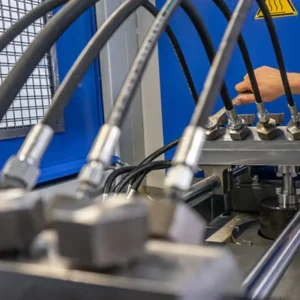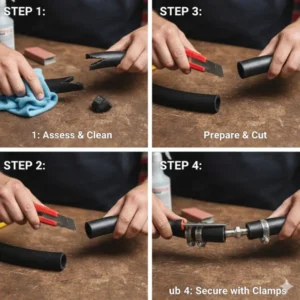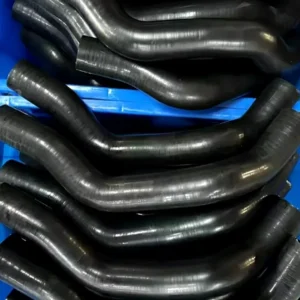Choosing the correct air hose material is critical for optimizing the performance and longevity of your pneumatic tools, whether you’re in a professional workshop or a home garage. The main options, rubber (SBR/EPDM) and PVC (Polyvinyl Chloride), each offer distinct trade-offs in flexibility, durability, and cost.
This guide explores the essential differences between rubber and PVC air hoses to help you make an informed decision. We will look at how each material performs under varying temperatures, their relative weights, and resistance to abrasion and common shop chemicals.
What is a Rubber Air Hose?
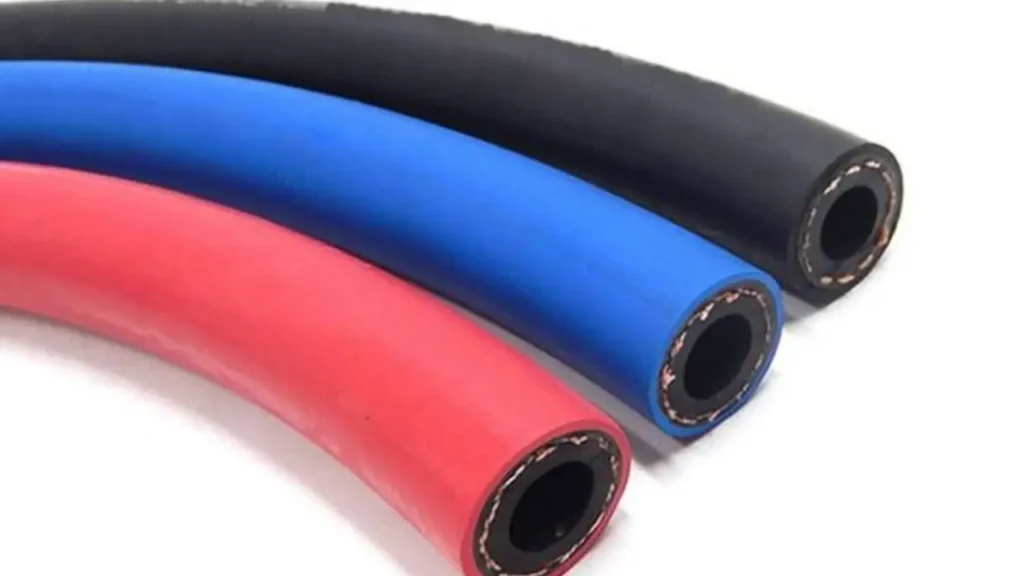
A rubber air hose is a specialized, flexible tube designed to convey compressed air from a compressor to pneumatic tools or equipment. These hoses are typically constructed from synthetic rubber compounds, such as SBR (Styrene-Butadiene Rubber) or EPDM (Ethylene Propylene Diene Monomer), prized for their resilience.
They are the preferred choice in professional workshops and industrial settings due to their excellent durability and superior performance characteristics. Rubber hoses generally outperform plastic alternatives, especially under demanding conditions involving high pressure and frequent physical stress.
- Construction and Durability Rubber hoses feature a robust, multi-layered design with a synthetic inner tube and a woven textile or spiral reinforcement layer. This construction provides exceptional strength, making them highly resistant to crushing, kinking, and internal abrasion from continuous high-pressure airflow, ensuring a longer service life.
- Temperature Flexibility A major advantage is their ability to maintain flexibility across a wide temperature range, performing well in both the intense heat of industrial environments and the sub-zero cold of outdoor job sites. This property prevents stiffening and cracking, which is essential for safe handling and efficient operation.
- Resistance to Elements These hoses are specifically formulated to resist common industrial hazards, including oil, grease, mild chemicals, and ozone. This chemical resistance prevents the hose material from deteriorating prematurely when exposed to lubricants or environmental factors, securing the hose’s integrity over time.
- Preferred Industrial Choice Rubber air hoses are standard equipment in demanding applications such as automotive repair, construction, and manufacturing, where reliable performance is non-negotiable. Their heavy-duty nature and consistent performance under pressure make them the industry benchmark for professional-grade air delivery systems.
What is a PVC Air Hose?
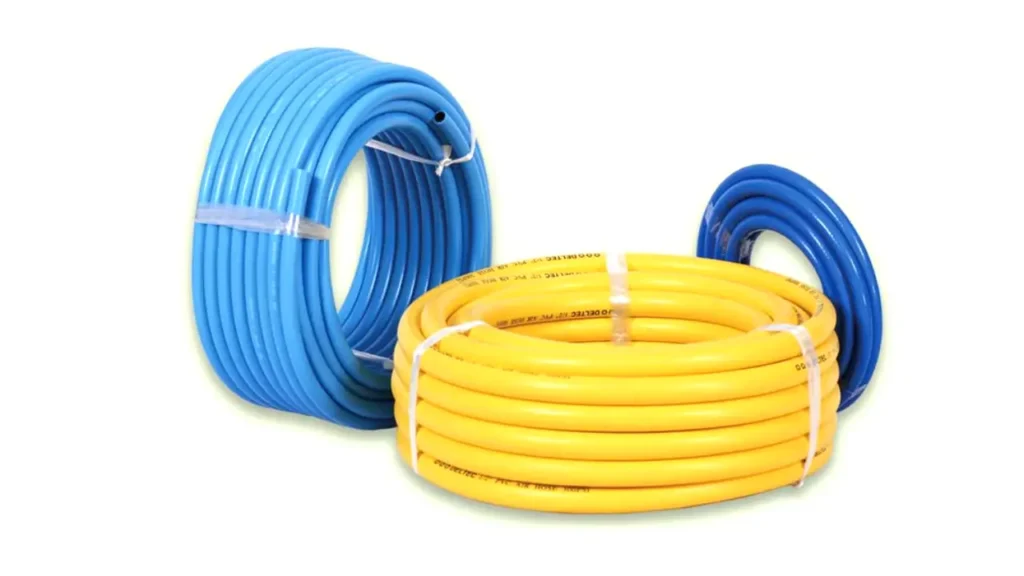
A PVC Air Hose is a flexible tube made from Polyvinyl Chloride plastic, designed specifically for conveying compressed air from a compressor to pneumatic tools or equipment. These hoses are popular due to their light weight and relatively low cost, making them a common choice for general-purpose applications.
They are typically reinforced with braided synthetic fibers to provide strength and stability against internal air pressure. While offering good performance in moderate conditions, PVC hoses are particularly sensitive to temperature fluctuations, becoming stiff in the cold.
- Material and Composition PVC hoses are constructed primarily from thermoplastic material, which allows for good flexibility at room temperature. The material is often compounded with plasticizers to enhance its pliability, and a textile braiding is embedded to increase the hose’s working pressure rating and prevent excessive ballooning.
- Key Characteristics These hoses are known for being lightweight and easy to coil and store, offering good handling for casual or light-duty use in workshops and garages. However, they lack the memory and cold-weather flexibility of rubber, often developing a coil set that makes them difficult to straighten out.
- Performance in Temperature One major drawback is their sensitivity to temperature. In cold environments, PVC hoses tend to stiffen dramatically, making them unwieldy and prone to cracking or kinking. In contrast, extreme heat can cause the material to soften and potentially affect its maximum pressure rating.
- Cost and Application PVC air hoses are usually the most economical option among air hose materials, serving as an excellent budget choice for hobbyists and infrequent users. They are best suited for indoor, moderate-temperature environments where heavy abrasion or high-pressure, continuous-duty cycles are not major concerns.
Rubber vs PVC Air Hose
Choosing between rubber and PVC air hoses is essential for optimizing the performance of your pneumatic system. The primary differences lie in their material composition, which directly impacts their flexibility, durability, and resilience across various working environments and temperatures.
Understanding these key distinctions will help you select the most suitable hose for your specific application, balancing factors like initial cost against long-term operational lifespan and handling comfort in the workshop.
Flexibility and Handling
Rubber hoses maintain excellent flexibility across a broad range of temperatures, particularly in cold environments where they remain pliable and easy to coil or uncoil. This high elasticity prevents kinking and significantly improves user handling, reducing the effort needed to maneuver the hose around obstacles on the shop floor.
PVC hoses, while flexible at room temperature, exhibit poor cold-weather performance, often becoming stiff, brittle, and difficult to manage. This lack of flexibility in the cold can lead to a phenomenon known as “coil memory,” where the hose resists lying flat, creating trip hazards and hindering efficient operation.
Durability and Abrasion Resistance
Rubber hoses, typically made from synthetic compounds like SBR or EPDM, possess superior durability and resistance to abrasion, cuts, and punctures. Their robust, heavier construction is built to withstand dragging across concrete floors, sharp edges, and general misuse common in demanding industrial settings.
PVC is a thermoplastic material that is inherently less resistant to physical damage than rubber. While durable enough for light use, PVC hoses are more susceptible to wear and tear from friction and can be easily nicked or cut, potentially leading to premature failure, especially under heavy, continuous use.
Weight and Portability
PVC hoses are significantly lighter than their rubber counterparts of the same size and length. This reduced weight is a major advantage for applications requiring the hose to be carried or lifted frequently, minimizing user fatigue during prolonged use and making temporary setups easier to manage.
Rubber hoses are considerably heavier due to their dense, multi-layered construction and thicker wall materials designed for superior pressure retention and protection. While the weight aids in keeping the hose flat on the ground and reduces coil memory, it can make transportation and clean-up more demanding for the operator.
Temperature Performance
Rubber hoses excel in extreme temperature environments, maintaining operational integrity in very cold conditions (down to −40∘F) without stiffening, and performing reliably in very hot conditions. This wide temperature tolerance is crucial for outdoor construction or welding applications.
PVC hoses have a restricted temperature range; they become noticeably rigid below freezing and may crack if forced to bend. Conversely, high heat can cause PVC to soften, potentially compromising its structural integrity and lowering its maximum working pressure, making it unsuitable for hot air transfer.
Cost and Lifespan
PVC hoses are the clear winner on initial cost, offering a substantially cheaper option upfront for consumers and bulk purchasers. This lower purchase price makes PVC the preferred economic choice for budget-conscious buyers or for applications where the hose is used infrequently.
Rubber hoses have a higher initial cost, but their superior durability, extended service life, and resistance to degradation often translate into a lower total cost of ownership over time. Their longevity means fewer replacements and less downtime compared to frequently replacing a cheaper PVC hose.
| Feature | Rubber Air Hose | PVC Air Hose |
| Flexibility | Excellent, remains flexible in extreme cold. | Good at room temperature, stiffens significantly in the cold. |
| Durability | Superior resistance to abrasion, cuts, and chemicals. | Lower resistance; prone to wear and kinking under heavy use. |
| Weight | Heavier and denser construction. | Lightweight and easy to handle and store. |
| Temperature Range | Wide range (e.g., −40∘F to 180∘F); resists cracking in cold. | Narrower range; becomes brittle in cold and soft in high heat. |
| Cost | Higher initial purchase price. | Lower and more economical initial cost. |
How to Choose Rubber and PVC Air Hoses?
Choosing between rubber and PVC air hoses depends entirely on balancing your operational needs with budget constraints and environmental factors. The selection process should evaluate where the hose will be used, how frequently, and the range of temperatures it will be exposed to for optimal performance.
To make the right choice, focus on comparing key characteristics like flexibility in the cold, overall durability, weight, and initial cost. Aligning these material properties with your specific application will ensure you maximize efficiency and hose lifespan, minimizing replacement frequency.
- Consider Operating Temperature If you work in a cold climate or often outdoors, choose rubber as it remains flexible and manageable below freezing. PVC stiffens severely in the cold, making it hard to coil and increasing the risk of kinking and cracking. .
- Assess Durability Needs For demanding, heavy-duty use involving dragging the hose over concrete, near sharp edges, or exposure to oils, opt for rubber. Its superior synthetic construction resists abrasion, crushing, and chemical degradation better than the more vulnerable PVC material.
- Evaluate Weight and Portability If the hose needs to be frequently carried up ladders, moved across large distances, or requires low user fatigue, select the lightweight PVC hose. The reduced bulk of PVC is excellent for portability, although this benefit sacrifices some of the robust durability found in rubber.
- Determine Budget and Usage Frequency For infrequent, light-duty use in a temperature-controlled area (like a home garage), a PVC hose offers the best value due to its significantly lower initial cost. However, for professional, daily use, the higher upfront cost of rubber yields a better long-term investment.
- Check Pressure and Flow Requirements Ensure the hose’s maximum working pressure rating meets or exceeds your tool requirements, regardless of material. Both rubber and reinforced PVC hoses come in various ratings, but heavy-duty rubber is typically available in higher-pressure specifications for continuous industrial applications.
Conclusion
The choice between a rubber air hose and a PVC air hose ultimately depends on your environment and specific operational demands. Rubber offers superior flexibility in cold weather and unmatched durability against abrasion and chemicals, making it the better long-term investment for industrial and professional settings.
Conversely, PVC air hoses are significantly lighter and more cost-effective upfront, making them a practical choice for light-duty, general-purpose use where extreme cold or heavy wear is not a concern. Weighing your specific needs against the material properties ensures peak productivity.
For businesses that require the highest quality, most reliable, and durable air and fluid transfer solutions, prioritizing rubber hoses is key. When it’s time to stock your workshop with dependable, heavy-duty inventory, make the strategic decision to get wholesale rubber hoses from our Gushan Rubber. We guarantee performance.

